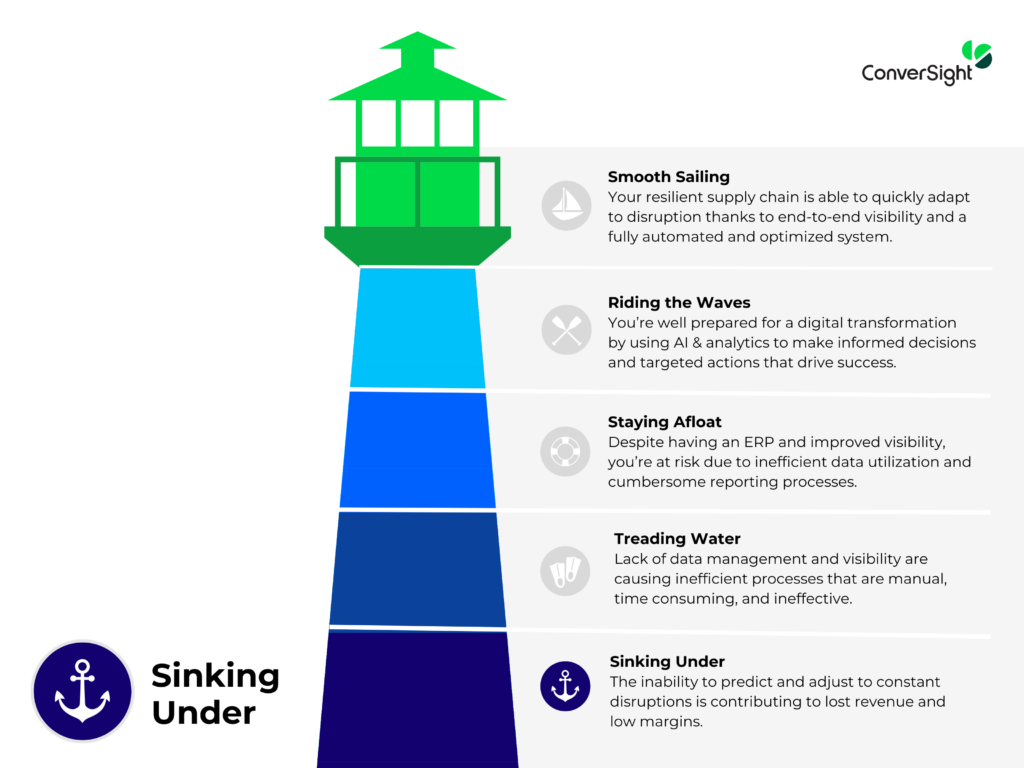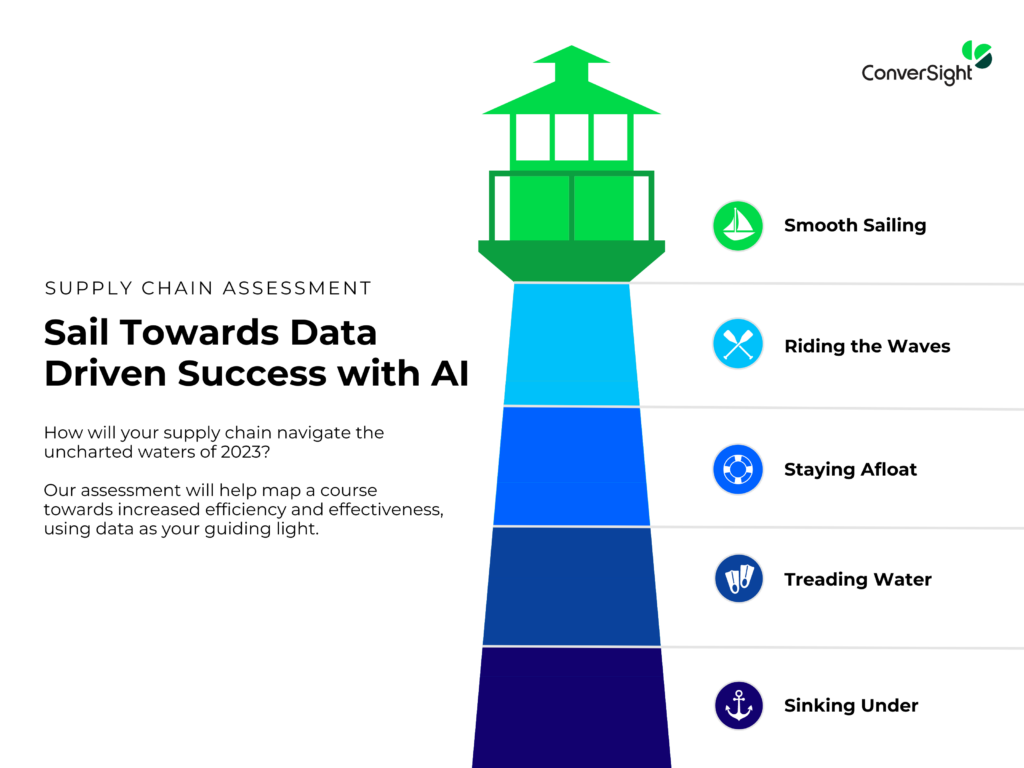Weather The Supply Chain Storms of 2023
2023 is upon us, and many companies are wondering whether their supply chains are ready for the coming tides. ConverSight has developed an assessment to test whether your data collection and analytics processes are up to snuff, allowing you to get an at-glance view of how your processes stack up to oncoming challenges.
Since beginning our company in 2017, ConverSight has been focused on arming companies with conversational analytics solutions that provide instant insight across departments, channels, and every level of your supply chain, sales, and other key components of your top line. The next generation of analytics is Augmented Analytics, whereby companies can glean insights through having a conversation with their data, through AI.
Read on to see the levels of readiness, and how your business can be better prepared for 2023’s inevitable supply chain woes.
How Our Supply Chain Assessment Works
Users will be presented with nine questions that will ask them to analyze their companies’ data and technology stack, as well as hypotheticals about how their supply chain would react when presented with challenging circumstances. Once the information is inputted, users will be presented with five stages of supply chain resiliency, and be put into one of the five categories, from least to most effective: Sinking Under, Treading Water, Staying Afloat, Riding The Waves, and Smooth Sailing.
Let’s take a look at the five stages of supply chain resilience:
Stage 1 – Sinking Under

Do the never-ending disruptions have you feeling under water? From overstocks and stockouts, to pricing fluctuations and COVID disruptions, your supply chain is stuck in an everlasting storm.
Although you have data collected, it’s spread across systems and usually slows the decision making process. Tasks are repetitive and manual, while operations are out-of-date. Your current strategy has proven it’s in need of revision, consequently resulting in lost revenue and low margins.
Desperate to get off the sinking ship? It’s time to take the plunge towards a digital transformation and allow AI-analytics to throw you a life preserver.
Stage 2 – Treading Water

Lost in a sea full of data, you’re working hard to stay afloat.
Visibility into operations and inventory is minimal, and your data exists across various excel sheets or locations. Processes are time consuming and manual, and working with data is cumbersome and complicated, often requiring help from a data scientist or analyst. Decision-making feels more like guesswork than a strategic game plan – and it’s costing you valuable inventory, shelf space and resources.
Our recommendation:
Gaining better visibility into your operations is the first step towards weathering today’s supply chain climate. To do so, you need to centralize your data into one location for optimal visibility across datasets. Once connected, you’re able to ask questions and access real-time information on demand. This gives you a better pulse on your current supply chain environment, knowing what’s occurring in every corner of your business.
With a better understanding of what’s happening in real-time, you’re able to use data as a navigator to make smarter, faster and more efficient decisions, improving cash flow and margins.
Stage 3 – Staying Afloat

While operations may feel effortless, you’re lacking wind in your sails and susceptible to risk at any point.
You’re collecting enormous amounts of data within an ERP, CRM or IMS, all living in one central location. You have better visibility into your supply chain, but there are underlying gaps and planning for the future is one big fog. Data is underutilized, and cumbersome reporting causes limitations of its own. Whether you’re relying on canned reports within your ERP, or have a team of analysts manually pulling, manipulating and delivering reports, these limitations are time consuming, susceptible to human error and can quickly cause you to sink in a volatile environment.
Our recommendation:
Real-time custom reporting delivers the exact information you need, right when you need it. By automating reports, you’re able to free up resources to work on more critical tasks, all while taking the guesswork out of planning and doing.
This new wave of reporting uses historical trends, patterns, and your library of existing data to auto-generate recurring reports like inventory management, POs, and dynamic demand forecasts – all with AI-driven precision. AI-powered forecasts allow you to plan with confidence, maximize cash flow, and limit disruption in real-time. While automating time consuming tasks like ordering, inventory tracking, performance monitoring and cost analysis drives higher operational efficiency.
With the ability to predict low inventory, bottlenecks and anomalies ahead of time, you’re able to quickly adjust before it spirals into costly errors.
With the help of automation and advanced reporting, planning for the future is clear as day.
Stage 4 – Riding The Waves

You’re all onboard for a digital transformation, and you frequently use data to make smarter, faster decisions. You have a pulse on operations in real-time, and the ability to predict inventory and customer needs in the future. You’re ready to turn those insights into action with AI-powered recommendations that help guide the decision making process and have you sailing into the sunset.
Our recommendation:
Prescriptive analytics make it easy and possible for all users – regardless of role or function – to interact with, and make decisions from data. With the ability to analyze buying patterns and trends, AI can accurately produce recommended purchase orders, work orders and guided actions with your desired business outcomes in mind.
With an eagle eye view on current operations, future predictions, and recommended actions – you have an AI-powered system working around-the-clock to deliver a fully optimized, efficient supply chain primed to navigate the waters of 2023.
Stage 5 – Smooth Sailing

Hats off! In the face of challenging conditions, analytics is your guiding light.
While disruption and disaster are bound to occur, you have the systems in place to adapt and adjust. You’ve achieved end-to-end visibility, and your inventory management is under control. With a fully automated and optimized system in place, you’ll come out unphased the next time disaster strikes.
Our recommendation:
How much are you investing to manage your supply chain effectively? Achieving this success doesn’t require a significant investment in resources, time, money or effort. Instead, let Athena carry the load. Athena, an AI-Assistant works around-the-clock to deliver real-time insights, reports, and recommendations on demand. She has the expertise to oversee and analyze your entire supply chain, providing insight into current and future trends and suggesting strategic next steps. This alleviates your workload, saves costs, and allows your team to focus on more high-impact projects.
With Athena as your captain, you’ll be guided to the shore of success.
Sail Towards Success With ConverSight
You are never alone on your journey to supply chain optimization! Hundreds of other companies are dealing with the same problems that you may be struggling with. The good news is, these problems can be managed within and lead to increased visibility, cash flow, and overall supply chain resiliency for your organization.
To get started on optimizing your supply chain and increasing cash flow, take the assessment or schedule a demo today to get started.
